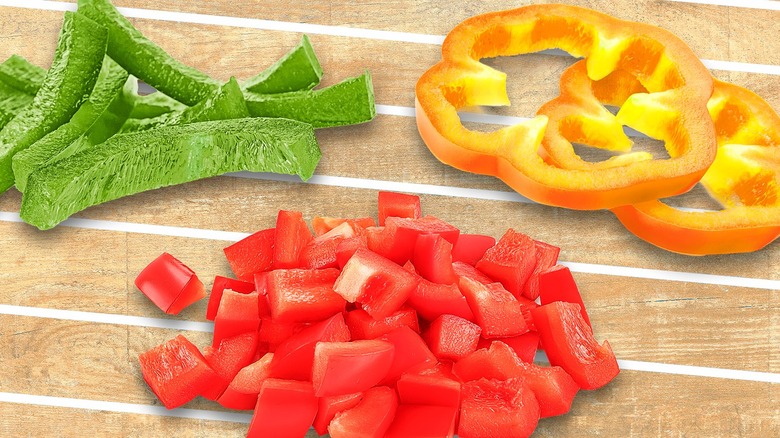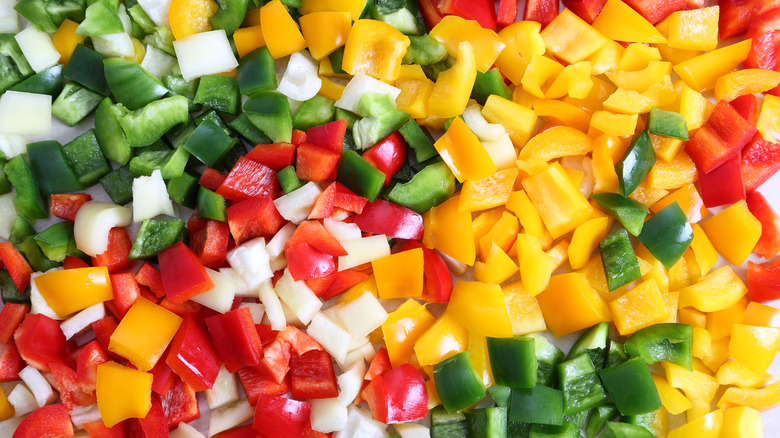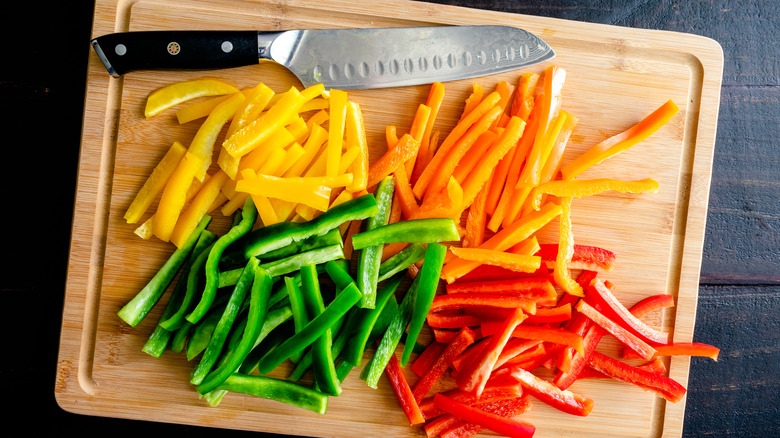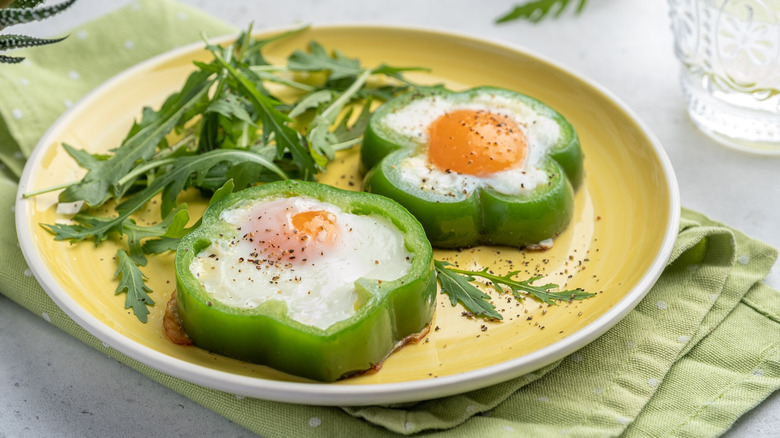3 Popular Ways To Cut Bell Peppers And How To Best Use Them
Bell peppers are a versatile fruit (that's right — not a vegetable) that are delicious in a variety of dishes from an omelet to stir fry. The crunchy and colorful vegetables add both flavor and texture to any dish they're added to. They also have a lot of health benefits, because they're high in nutrients like vitamin C, vitamin K, and potassium. Bell peppers come in different colors like green, red, yellow, or orange, but no matter what variety, it's important to know how to cut them to match the recipe.
That's because unless stuffed peppers are on tonight's menu, you'll need to dice the peppers, cut them into strips, or make rings. For all of the methods, it's important to remove the veins and seeds from inside the pepper. A spoon is an easy hack to scoop out the insides of the pepper — just be careful not to remove too much of the flesh. You can also go the traditional route and use a knife. Before we get into the different ways to cut bell peppers, grab your sharpest knife and a sturdy cutting board to make it easier.
Dicing bell peppers
Diced peppers are probably one of the more common cutting techniques. There are a few ways to dice a pepper, but we'll explain the easiest method. Use a sharp knife to cut off the top and bottom, then make a vertical cut to open the pepper. Use a knife or a spoon to remove the seeds and veins. Then slice the pepper into long strips, place them into a pile, and match the ends so you have even pieces. Now dice the peppers into quarter-inch pieces. Another option is to start by cutting the pepper in half, scoping out the insides, cutting into strips, then dicing.
What recipes use diced bell peppers? Scrambled eggs and omelets are two common dishes that use bell peppers. To avoid crunchy, undercooked peppers, sauté them before adding to the eggs. Another breakfast recipe to use those diced peppers is skillet potatoes or home fries. If you're making a hearty pot of chili, diced peppers are an integral ingredient. We think another delicious idea is a sheet-pan meal with onions, peppers, other vegetables, and sausages.
Using pepper strips
Slicing peppers into strips is similar to dicing, with fewer steps. This is often referred to as Julienning (a French culinary term) if the peppers are sliced thin. Start by cutting off the top and bottom, making a vertical cut, then continue cutting along the edge until the pepper is open. Remove the insides then slice the pepper into even pieces. For Julienned peppers, you'll want strips that are ¼ to ⅛ inch in thickness, or cut them thicker for more texture.
Bell pepper strips are great for tacos and fajitas. You'll sauté the peppers along with onion and other ingredients until they're softened, then follow the rest of your recipe. Other recipes with pepper strips include a stir fry with your go-to protein and vegetables, Philly cheesesteak sandwiches, or use them to upgrade a frozen pizza. And if you like raw bell peppers, thicker strips can replace crackers or chips for a healthy, crunchy snack on their own or with hummus.
Cutting peppers into rings
Rings are a more unconventional way to cut peppers compared to the other methods we've explained, but they require less cutting. For pepper rings, start by cutting off the top and stem. Now use a spoon or knife to scoop out the insides of the pepper. Lay the hollowed pepper on its side and cut the pepper into rings to your preferred thickness, working your to the bottom. You can toss the bottom of the pepper or dice it and use it for another recipe.
How can you use bell pepper slices? A healthy, hearty breakfast idea is to place them on a baking sheet lined with parchment paper. You can crack an egg into the center, season with salt and black pepper, top with shredded cheese, and bake in the oven until the eggs set. You can also cook this in a pan on your stovetop, or whisk the eggs before filling the rings if you prefer scrambled eggs. You can also dredge the pepper rings in flour, egg, and breadcrumbs then fry them in oil for an alternative to onion rings. And if you have any leftover bell pepper rings, use them on a sandwich for crunch in every bite.



